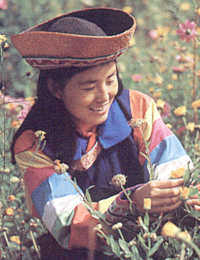 The Tu ethnic minority lives in the northwestern part of China, with a population of 191,624 (by 1990). It is concentrated in the Minhe and Datong counties and the Huzhu Tu Autonomous County in the eastern Qinghai Province. Others live sparsely in the Tianzhu Tibetan Autonomous County in Gansu Province.
The Tu ethnic minority lives in the northwestern part of China, with a population of 191,624 (by 1990). It is concentrated in the Minhe and Datong counties and the Huzhu Tu Autonomous County in the eastern Qinghai Province. Others live sparsely in the Tianzhu Tibetan Autonomous County in Gansu Province.
The Tu people have their own spoken language. Their language, which is comprised of three dialects, belongs to the Mongolian Austronesian of the Altaic Phylum. The Tu people have no written alphabet. Chinese and Tibetan alphabets are in common use, although a new written system based on the Chinese Phonetic Alphabet was created for them in 1979.
The Tus call themselves "Mongguer" (Mongolians) or "Chahan Mongguer" (White Mongolians), which gives expression to the close relations that existed between the ancient Tu and the Mongolian people. Popular legends have it that their ancestors were Mongolian soldiers. Mongolian troops under Genghis Khan made their appearance in Xining (now capital of Qinghai Province), which exercised jurisdiction over Huzhu County during the Yuan Dynasty (1271-1368). They intermarried with the indigenous Houers of what is now Huzhu County. During their long history, they formed their own unique group by absorbing members of the Han, Tibetan, Mongolian, and other neighboring tribes. "Huoer" was long ago a Tibetan name for the nomadic herdsmen who lived in northern Tibet and vast areas north of Tibet. In modern times the term refers specifically to the Tu people.
In ancient times, the Tu people were mainly engaged in sheep ranching and other animal husbandry. In the late Yuan Dynasty and early Ming Dynasty (1368-1644), farming developed very quickly and the Tu people transitioned to farming with animal husbandry as a secondary form of livelihood. Since the founding of the People's Republic of China, the Huzhu Tu Autonomous County has set up a fair number of industrial and mining enterprises.
Most Tus believe in Tibetan Buddhism (Lamaism), and under the influence of the Han people, they also believe in Taoism.
The Tus are especially hospitable. All guests, including passersby and anyone that should ask for an accommodation, are welcomed with open arms. Traditionally, guests are treated to a five-course meal. The first course consists of buttered tea (made by mixing tea with butter and salt in a churn), deep fried buns, and steamed twisted rolls made of flour. The second course includes fried puffy shredded dough (or deep fried noodles) with stewed beef ribs. The third course includes a variety of stuffed buns, followed by the fourth-course of meat eaten with the fingers. The meal isn't complete without the last course of the Tu's homemade long noodles.
The Tu ethnic minority is renowned for their talent for singing and dancing. The Hua'er Festival, a traditional ballad-singing gathering, is held once a year, when thousands upon thousands of singers and young people gather from all over the area to get together and sing to their hearts' content. Other ceremonious festivals include the Spring Festival, the Dragon Boat Festival, the Nadun Festival, etc. The Nadun Festival, also known as "July Meeting", is popular among the Tus. It lasts nearly two months, from July the thirteenth to the early September and is said to be the longest lasting festival in the world. The festival was originally held in memory of a carpenter well known for his wit, but it has now become a carnival celebrating good harvests.
